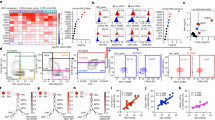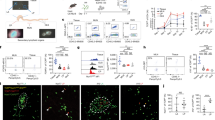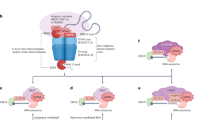Abstract
Toll-like receptors (TLRs) recognize microbial components, and evoke inflammation and immune responses1,2,3. TLR stimulation activates complex gene expression networks that regulate the magnitude and duration of the immune reaction. Here we identify the TLR-inducible gene Zc3h12a as an immune response modifier that has an essential role in preventing immune disorders. Zc3h12a-deficient mice suffered from severe anaemia, and most died within 12 weeks. Zc3h12a-/- mice also showed augmented serum immunoglobulin levels and autoantibody production, together with a greatly increased number of plasma cells, as well as infiltration of plasma cells to the lung. Most Zc3h12a-/- splenic T cells showed effector/memory characteristics and produced interferon-γ in response to T-cell receptor stimulation. Macrophages from Zc3h12a-/- mice showed highly increased production of interleukin (IL)-6 and IL-12p40 (also known as IL12b), but not TNF, in response to TLR ligands. Although the activation of TLR signalling pathways was normal, Il6 messenger RNA decay was severely impaired in Zc3h12a-/- macrophages. Overexpression of Zc3h12a accelerated Il6 mRNA degradation via its 3′-untranslated region (UTR), and destabilized RNAs with 3′-UTRs for genes including Il6, Il12p40 and the calcitonin receptor gene Calcr. Zc3h12a contains a putative amino-terminal nuclease domain, and the expressed protein had RNase activity, consistent with a role in the decay of Il6 mRNA. Together, these results indicate that Zc3h12a is an essential RNase that prevents immune disorders by directly controlling the stability of a set of inflammatory genes.
This is a preview of subscription content, access via your institution
Access options
Subscribe to this journal
Receive 51 print issues and online access
$199.00 per year
only $3.90 per issue
Buy this article
- Purchase on Springer Link
- Instant access to full article PDF
Prices may be subject to local taxes which are calculated during checkout




Similar content being viewed by others
Accession codes
Primary accessions
Gene Expression Omnibus
Data deposits
Microarray data are deposited in the Gene Expression Omnibus (accession number GSE14890 for series of Myd88-/- and Trif-/- macrophages, and GSE14891 for series of Zc3h12a-/- macrophages). The structure model of Zc3h12a nuclease domain has been deposited in the Protein Model DataBase (PMDB) under accession number PM0075640.
References
Akira, S., Uematsu, S. & Takeuchi, O. Pathogen recognition and innate immunity. Cell 124, 783–801 (2006)
Beutler, B. et al. Genetic analysis of host resistance: Toll-like receptor signaling and immunity at large. Annu. Rev. Immunol. 24, 353–389 (2006)
Medzhitov, R. Recognition of microorganisms and activation of the immune response. Nature 449, 819–826 (2007)
Anderson, P. Post-transcriptional control of cytokine production. Nature Immunol. 9, 353–359 (2008)
Barabino, S. M., Hubner, W., Jenny, A., Minvielle-Sebastia, L. & Keller, W. The 30-kD subunit of mammalian cleavage and polyadenylation specificity factor and its yeast homolog are RNA-binding zinc finger proteins. Genes Dev. 11, 1703–1716 (1997)
Kanadia, R. N. et al. A muscleblind knockout model for myotonic dystrophy. Science 302, 1978–1980 (2003)
Zhao, W., Liu, M. & Kirkwood, K. L. p38α stabilizes interleukin-6 mRNA via multiple AU-rich elements. J. Biol. Chem. 283, 1778–1785 (2008)
Paschoud, S. et al. Destabilization of interleukin-6 mRNA requires a putative RNA stem-loop structure, an AU-rich element, and the RNA-binding protein AUF1. Mol. Cell. Biol. 26, 8228–8241 (2006)
Datta, S. et al. Tristetraprolin regulates CXCL1 (KC) mRNA stability. J. Immunol. 180, 2545–2552 (2008)
Taylor, G. A. et al. A pathogenetic role for TNF-α in the syndrome of cachexia, arthritis, and autoimmunity resulting from tristetraprolin (TTP) deficiency. Immunity 4, 445–454 (1996)
Zhou, L. et al. Monocyte chemoattractant protein-1 induces a novel transcription factor that causes cardiac myocyte apoptosis and ventricular dysfunction. Circ. Res. 98, 1177–1185 (2006)
Liang, J. et al. A novel CCCH-zinc finger protein family regulates proinflammatory activation of macrophages. J. Biol. Chem. 283, 6337–6346 (2008)
Vinuesa, C. G. et al. A RING-type ubiquitin ligase family member required to repress follicular helper T cells and autoimmunity. Nature 435, 452–458 (2005)
Yu, D. et al. Roquin represses autoimmunity by limiting inducible T-cell co-stimulator messenger RNA. Nature 450, 299–303 (2007)
Liang, J., Song, W., Tromp, G., Kolattukudy, P. E. & Fu, M. Genome-wide survey and expression profiling of CCCH-zinc finger family reveals a functional module in macrophage activation. PLoS One 3, e2880 (2008)
Sato, S. et al. Essential function for the kinase TAK1 in innate and adaptive immune responses. Nature Immunol. 6, 1087–1095 (2005)
Fukuyama, H., Nimmerjahn, F. & Ravetch, J. V. The inhibitory Fcγ receptor modulates autoimmunity by limiting the accumulation of immunoglobulin G+ anti-DNA plasma cells. Nature Immunol. 6, 99–106 (2005)
Miyoshi, K., Uejima, H., Nagami-Okada, T., Siomi, H. & Siomi, M. C. In vitro RNA cleavage assay for Argonaute-family proteins. Methods Mol. Biol. 442, 29–43 (2008)
Kawagoe, T. et al. Sequential control of Toll-like receptor-dependent responses by IRAK1 and IRAK2. Nature Immunol. 9, 684–691 (2008)
Eswar, N. et al. Comparative protein structure modeling using MODELLER. Curr. Protoc. Bioinformatics Chapter 5 Unit 5.6 (2006)
Feng, M. et al. Roles of divalent metal ions in flap endonuclease-substrate interactions. Nature Struct. Mol. Biol. 11, 450–456 (2004)
Kinoshita, K. & Nakamura, H. eF-site and PDBjViewer: database and viewer for protein functional sites. Bioinformatics 20, 1329–1330 (2004)
Acknowledgements
We thank all colleagues in our laboratory, E. Kamada for secretarial assistance, and Y. Fujiwara, M. Kumagai and R. Abe for technical assistance. We thank S. Sato for discussions and W. Zhao and K. Kirkwood for plasmids. This work was supported by the Special Coordination Funds of the Japanese Ministry of Education, Culture, Sports, Science and Technology, grants from the Ministry of Health, Labour and Welfare in Japan, the Global Center of Excellence Program of Japan, and the NIH (P01 AI070167).
Author Contributions K.M. generated Zc3h12a-/- mice and performed most experiments. O.T. identified Zc3h12a, designed the research and wrote the paper. D.M.S. and H.N. carried out structural modelling. Y.K. analysed microarray data, and T.T. was responsible for histological analysis. T.K., T.M., T.S. and H.K. helped with experiments. S.A. designed the research and supervised the project.
Author information
Authors and Affiliations
Corresponding author
Supplementary information
Supplementary Figures
This file contains Supplementary Figures 1-10 with Legends (PDF 1852 kb)
Rights and permissions
About this article
Cite this article
Matsushita, K., Takeuchi, O., Standley, D. et al. Zc3h12a is an RNase essential for controlling immune responses by regulating mRNA decay. Nature 458, 1185–1190 (2009). https://doi.org/10.1038/nature07924
Received:
Accepted:
Published:
Issue Date:
DOI: https://doi.org/10.1038/nature07924
This article is cited by
-
Molecular mechanisms in colitis-associated colorectal cancer
Oncogenesis (2023)
-
MCPIP1 functions as a safeguard of early embryonic development
Scientific Reports (2023)
-
RBP–RNA interactions in the control of autoimmunity and autoinflammation
Cell Research (2023)
-
Inflammatory response in mouse lungs to haze episodes under different backgrounds of particulate matter exposure
Scientific Reports (2023)
-
Angiotensin II Increases Oxidative Stress and Inflammation in Female, But Not Male, Endothelial Cells
Cellular and Molecular Bioengineering (2023)
Comments
By submitting a comment you agree to abide by our Terms and Community Guidelines. If you find something abusive or that does not comply with our terms or guidelines please flag it as inappropriate.



